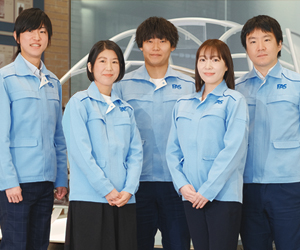In the extra edition, we feature detailed discussions with people from NTT Facilities Inc., which handled design and supervised construction, and Itoki Corporation, which was in charge of the interior.
Table of Contents
- Timeline of Construction of New Buildings and Campus and Original Design Concept
- Elegant Exterior of Shigaraki-Ware Bricks and Floors of River Gravel from the Echigawa River
- Communication in the Open-Plan Buildings and Campus
- Using the Koto Climate to Create an Eco-Friendly Office
- Receipt of the 2014 Nikkei New Office Award
Timeline of Construction of New Buildings and Campus and Original Design Concept
―First of all, could you describe the timeline of your participation in the project for the new FAS head office buildings and campus?
Mr. T.N., NTT Facilities
We were invited to take part in a competition. Our younger members spearheaded the project. I remember how thrilled they were, we all were, when our submission was chosen. After the competition, changes were made. The design was revised and the scope expanded, encompassing not only designing a single building but also refurbishment of the main gate and existing buildings. We tackled the expanded remit from the viewpoint of maximizing the appeal of the entire factory site.
Mr. K.N., Itoki
We took part in the FAS project from the rebuilding phase, so our discussions focused on new construction. We were sure Itoki’s track record and experience would prove useful.
NTT Facilities
I was impressed by the attractiveness of the site and its surrounding environment of abundant natural beauty. The old factory was utilized to refurbish existing buildings and campus. I loved the wonderfully open, spacious atmosphere the high ceilings and big rooms created.
Itoki
The site is brilliantly located, surrounded by natural beauty and easily visible from the shinkansen. Before refurbishment, I thought it had the air of a school. I recall the wide-open spaces and the brisk pace of work of employees of all age groups.
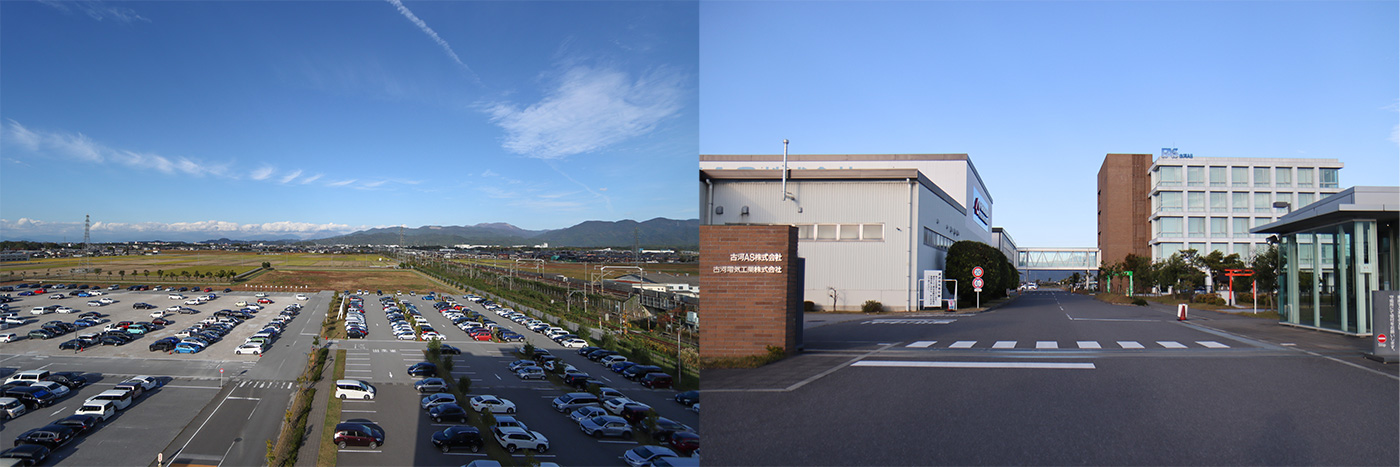
Left: View from inside one of the head-office buildings
Right: View of building exteriors from the front gate
Itoki
We worked with NTT Facilities, the designer, conducting repeated surveys and examinations of the current state of the site. We also circulated a questionnaire survey among all employees to gather their views on the office. Guided by the key phrase “From Shiga to the World,” our aim was to create a new head office that would serve as an engine for innovation and provide a supportive and worker-friendly office environment.
NTT Facilities
Determined to preserve the atmosphere FAS had cultivated of free and open communication, we felt that open spaces would be most appropriate, as they would accelerate communication among employees still further. Also, based on FAS’ corporate philosophy of valuing the people who make its R&D, manufacturing and personnel training possible, we conducted repeated interviews. Gradually, the concept coalesced into tangible form.
Concept at time of construction of the new buildings and campus
A global base from which to broadcast to the world, to make a new dream come true: A head office that maximizes productivity through concentration of functions while harmonizing with the abundance of nature
・ A model for FAS that generates new ways of working
・ A stimulating and openly communicative office where all employees know each other’s faces
・ Harmonious construction with roots in the community that makes use of the climate of Koto
・ A symbol of rationality, beauty and openness
(Excerpted from the Basic Design Document, February 2012)
―So in the end your concept brought together your thoughts and those of FAS.
In executing your design, what were you most particular about?
Itoki
In our questionnaire survey, we heard from many employees that free and open communication among employees in-house was a particularly valuable point. So we aimed for an open office that put that good point to work, an environment where people can work anywhere, anytime.
NTT Facilities
The ideal state we were striving for was a global base that FAS could proudly show off to the world, where rationality and functionality would be sublimated into the design of the new buildings and campus as a manufacturing nerve center, where everyone could feel FAS’ corporate culture of treasuring manufacturing.
For example, the structural frame that is such a salient feature of the exterior places the pillars and beams on the outside. This arrangement makes the interior easy to use while providing a sun-shading effect. Also, the steel-reinforced concrete structure achieves earthquake resistance and noise dampening.
We felt that a simple exterior that exudes rationality would make the design persuasive and create a landmark that would find favor with large numbers of people.
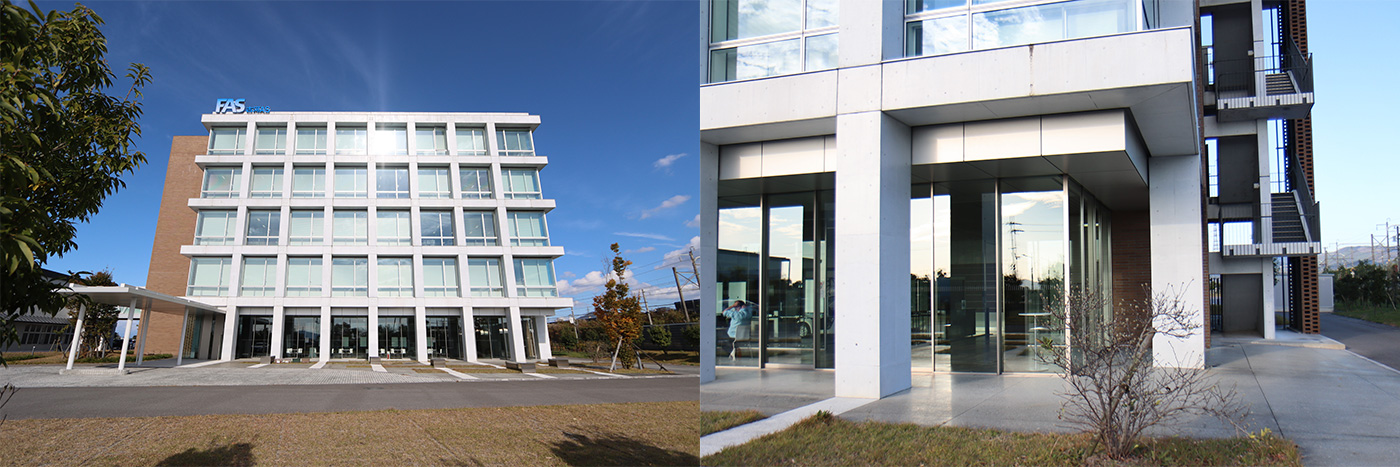
Frame structure that is both rational and aesthetically pleasing
―The exterior design is quite refined. I was surprised to learn that the starting point for you was rational functionality.
Also, while a distinctive design is always likely to find favor, I see that you incorporated local materials.

Left: Brightly sunlit passageway between buildings
Right: Spacious cafeteria
Elegant Exterior of Shigaraki-Ware Bricks and Floors of River Gravel from the Echigawa River
―In the exterior walls, you used Shigaraki-ware tiles, made of Shigaraki ceramics, a renowned product of Shiga. Walk us through the process by which you decided to adopt this material.
NTT Facilities
We settled on using Shigaraki bricks because Shigaraki ware is a local material. That decision is based on the policy of “incorporating local materials to create a head office that will be loved by the local community.” A key feature is that, instead of plastering the Shigaraki ware on the wall like tiles, we opted to lay them as bricks. This design choice prevents the material from falling off in the future. Also, we laid them in a way that made it possible to let gentle rays of sunlight into the interior.
Renowned as [the product of] one of the “six great ancient kilns of Japan,” Shigaraki ware has been one of Japan’s most accomplished pottery styles since ancient times. It is widely used as a construction material even today. Distinctive for its simple texture and sheen, Shigaraki ware seemed to us the perfect choice for the buildings and campus of FAS’ new head office.
You can see the same in the floor of the ground-floor entrance. Instead of laying stones or painting, we poured concrete mixed with polished river gravel from the Echigawa River, for a finish that will emerge gradually over time.
―Many office buildings degrade over time, with the result that the atmosphere in them becomes oppressive and gloomy. Your vision of creating buildings that gain character over time, focusing on fostering long-term relationships of harmonious coexistence and mutual prosperity with the land and the buildings’ users, embodies the basic philosophy and corporate philosophy of FAS, which is to contribute to a sustainable society.
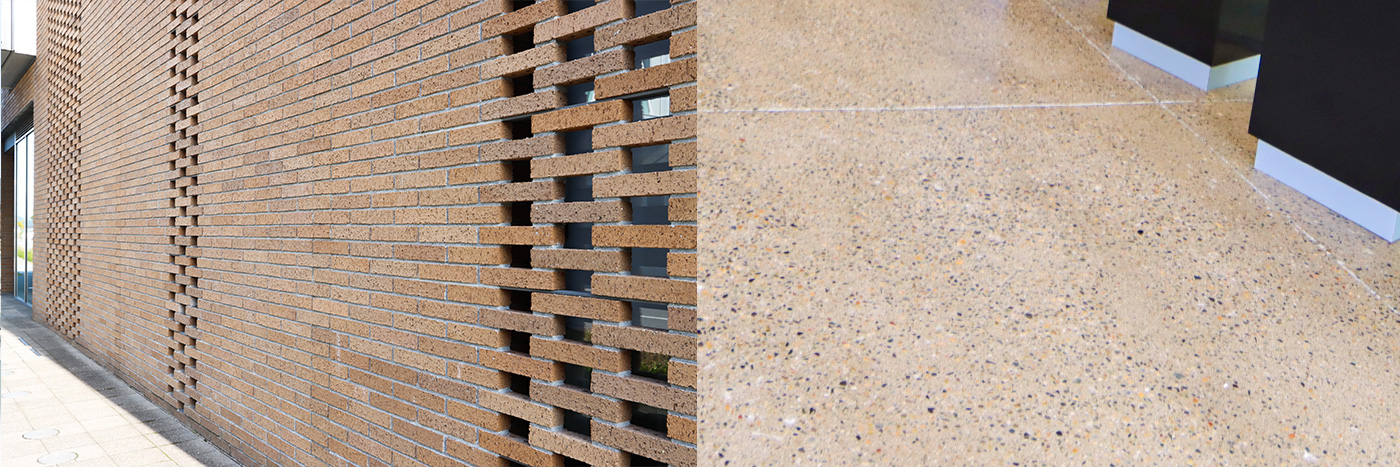
Left: The Shigaraki brick seems to soak up the sunlight.
Right: The floor brings out the texture of the river gravel from Echigawa River.
Communication in the Open-Plan Buildings and Campus
―Now I’d like to talk about the interior.
Throughout the buildings, the windows are huge and wide. The conference rooms are spacious and the ceilings are high. It’s quite a striking look, isn’t it?
NTT Facilities
The old office had one big room on each floor, offering end-to-end views and excellent lines of communication. To preserve that goodness, we placed an atrium in the middle of the new building. The result is a communication space that links each floor with the others, turning the whole building into one spacious room. Even the rooms that are divided from the rest, the conference rooms and executives’ offices, are divided by glass walls. Roll screens can be used to close off rooms when necessary, but in practice they are rarely used, as workers prefer the open-plan ambience.
―Which proves that the open plan is well aligned with the spirit of the Company. Is the paucity of spatial divisions on each floor for the same intention?
Itoki
We chose a design that does not erect walls, to enable as much active communication as possible, in line with FAS’ corporate culture.

Left: Open communication space
Lower right: Glass walls encourage open communication in the President’s Office.
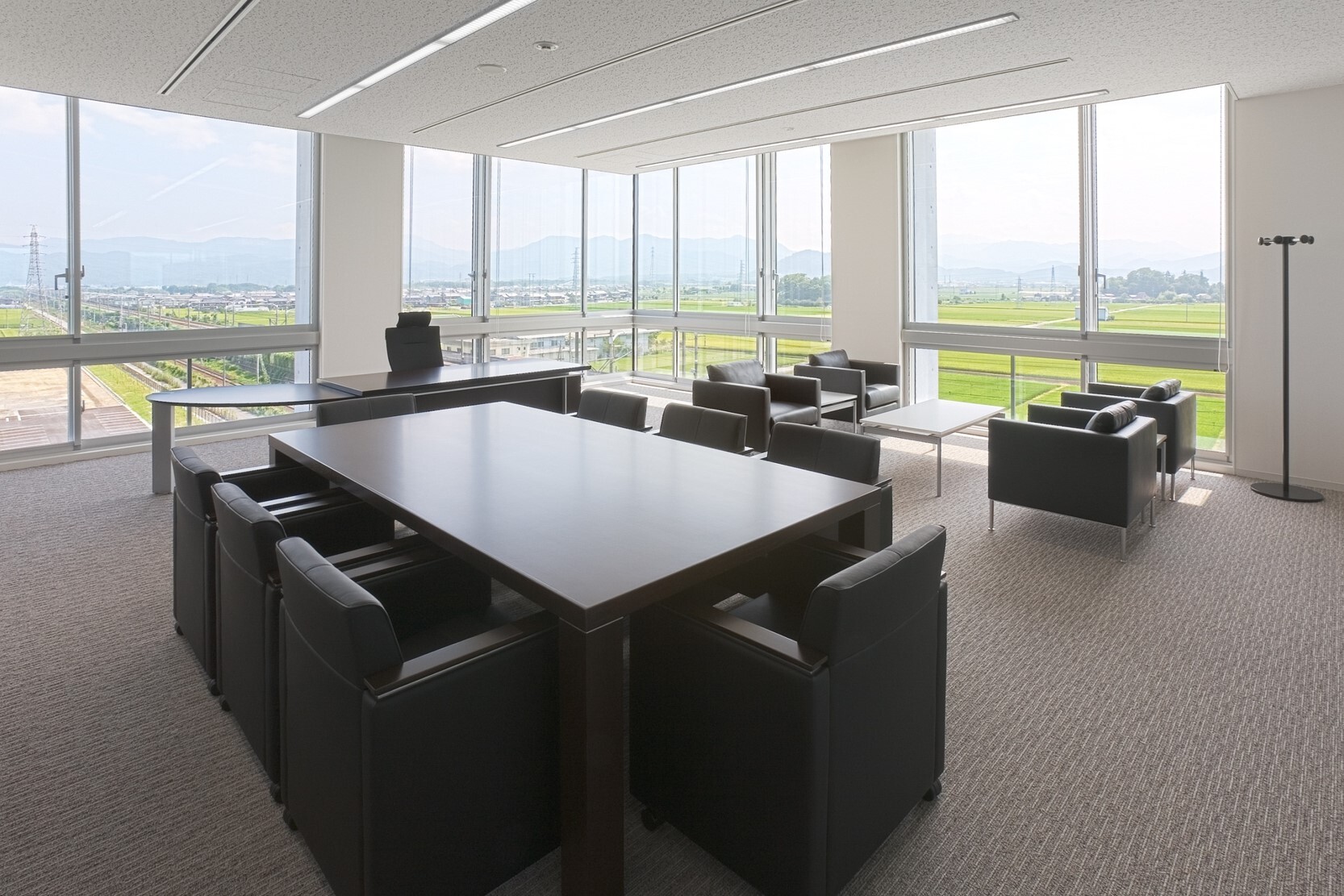
Using the Koto Climate to Create an Eco-Friendly Office
―The spacious interiors let in generous amounts of sunlight.
Can you tell us about the purpose of this design?
NTT Facilities
We wanted to create an eco-friendly office by taking maximum advantage of the weather conditions at this location. For example, we used heat from the sun to warm the interior in winter, when the days are short, and made use of the constant breeze from Lake Biwa all year round. Extensive use of sunlight enabled us to reduce electricity consumption for lighting, while the atrium in the middle of the building provides circulation through natural mechanisms, reducing the burden on HVAC systems. The atrium is outfitted with monitors, rendering visible figures related to weather, room temperature and energy consumption. By enabling users to open and close windows without the use of machinery, and to adjust climate-control and lighting settings themselves, and moreover to see with their own eyes the effects of these actions, we aimed to make the office environment truly comfortable while raising user awareness and saving energy. Thanks to these efforts, we achieved reductions in energy consumption of 53.5% for HVAC and 49% for lighting (based on measurement data gathered one year after completion).

Left, center: Sunlit interiors
Right: A monitor displays energy consumption and encourages users to make adjustments.
―So you cut energy consumption in half! That’s amazing. I can really see the merits of your design. It’s aesthetically pleasing, makes full use of regional characteristics, and is friendly to people and the environment.
―This design certainly seems to embody the philosophy of FAS. Can you tell us about other points where your design reflects the character or image of FAS?
Itoki
The annex features a communication space in a corner with an excellent window view. Also, the color scheme incorporates the light blue of the employees’ work uniforms and the naturally appealing colors of the furniture.

Left: Exhibition gallery immediately inside the front door, where guests are received
Right: Communication space with excellent window views
―The exhibition gallery is inventive and incorporates some advanced technologies. It presents an array of FAS products and technologies in an intuitive manner. We urge everyone who visits FAS head office to take a look at this gallery.
Receipt of the 2014 Nikkei New Office Award
―In 2014 FAS won the Kinki New Office Promotion Award of the 2014 Nikkei New Office Awards, co-sponsored by Nikkei, Inc. and the New Office Promotion Association. What were the events leading up to that achievement? What points clinched the award for you in your opinion?
Itoki
The Nikkei New Office Award is an award that recognizes original and inventive offices. Every year companies throughout Japan submit candidates for consideration. After we completed our design, NTT Facilities and our company approached FAS about entering the award competition, expressing our desire to submit this office, which incorporates the ideas of so many stakeholders, for a national award. Thanks to the hard work of everyone involved in the submission, we were able to submit the FAS head office for consideration. When we won the Nikkei New Office Award, we were absolutely thrilled.

If you visit FAS head office, we hope you will explore every detail of these fascinating buildings and campus.
FASNEXT wishes to thank the following organizations for their cooperation:
NTT Facilities Inc. https://www.ntt-f.co.jp/
Itoki Corporation https://www.itoki.jp/
![[Vol.9] Welcome to the 9th FAS NEXT! The Co-creation of FAS Head Office and FAS Starts Here](https://www.furukawaas.co.jp/wp-content/uploads/2022/03/IMG_0373-1024x683.jpg)
![[Vol.10] From Shiga to the World: Furukawa AS on the Global Stage](https://www.furukawaas.co.jp/wp-content/uploads/2023/08/DSC0116-1024x683.jpg)
![[Vol. 7] FAS in the World of Motorcycles (Part 2): From Hidden Parts of Stock Motorcycles to MotoGP](https://www.furukawaas.co.jp/wp-content/uploads/2021/08/56522010_m_3-1024x684.jpg)
